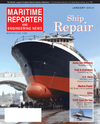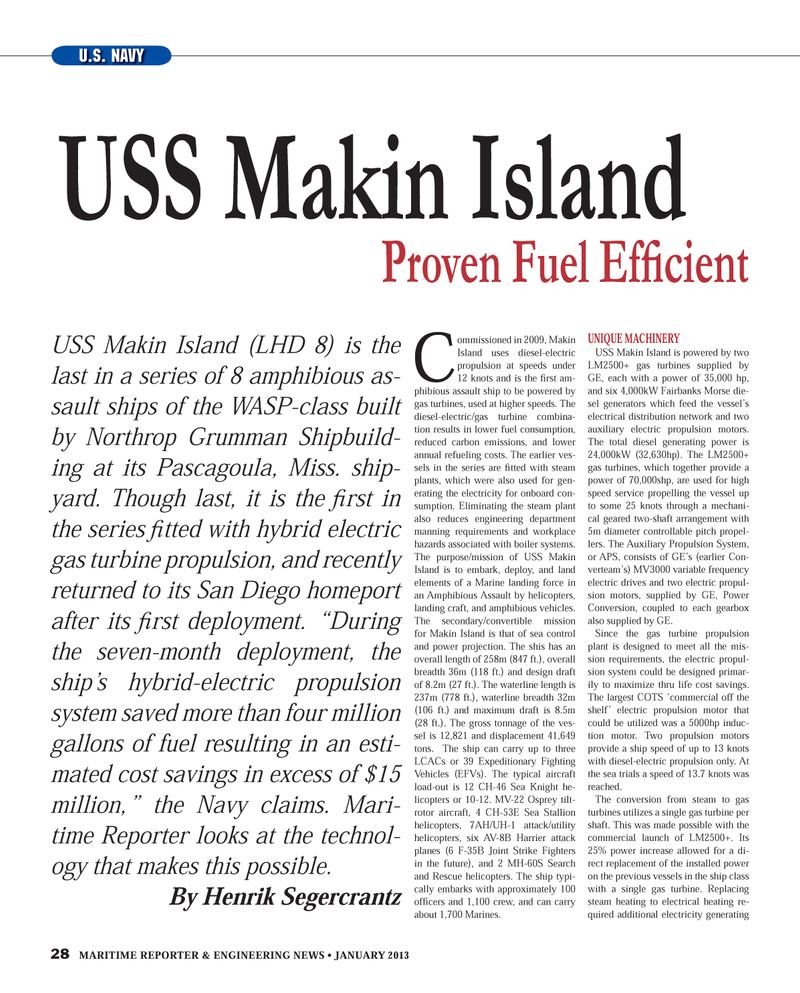
Page 28: of Maritime Reporter Magazine (January 2013)
Ship Repair & Conversion
Read this page in Pdf, Flash or Html5 edition of January 2013 Maritime Reporter Magazine
28 MARITIME REPORTER & ENGINEERING NEWS ? JANUARY 2013 Commissioned in 2009, Makin Island uses diesel-electric propulsion at speeds under 12 knots and is the Þ rst am- phibious assault ship to be powered by gas turbines, used at higher speeds. The diesel-electric/gas turbine combina-tion results in lower fuel consumption, reduced carbon emissions, and lower annual refueling costs. The earlier ves- sels in the series are Þ tted with steam plants, which were also used for gen-erating the electricity for onboard con-sumption. Eliminating the steam plant also reduces engineering department manning requirements and workplace hazards associated with boiler systems. The purpose/mission of USS Makin Island is to embark, deploy, and land elements of a Marine landing force in an Amphibious Assault by helicopters, landing craft, and amphibious vehicles. The secondary/convertible mission for Makin Island is that of sea control and power projection. The shis has an overall length of 258m (847 ft.), overall breadth 36m (118 ft.) and design draft of 8.2m (27 ft.). The waterline length is 237m (778 ft.), waterline breadth 32m (106 ft.) and maximum draft is 8.5m (28 ft.). The gross tonnage of the ves- sel is 12,821 and displacement 41,649 tons. The ship can carry up to three LCACs or 39 Expeditionary Fighting Vehicles (EFVs). The typical aircraft load-out is 12 CH-46 Sea Knight he-licopters or 10-12. MV-22 Osprey tilt- rotor aircraft, 4 CH-53E Sea Stallion helicopters, 7AH/UH-1 attack/utility helicopters, six AV-8B Harrier attack planes (6 F-35B Joint Strike Fighters in the future), and 2 MH-60S Search and Rescue helicopters. The ship typi- cally embarks with approximately 100 ofÞ cers and 1,100 crew, and can carry about 1,700 Marines. UNIQUE MACHINERY USS Makin Island is powered by two LM2500+ gas turbines supplied by GE, each with a power of 35,000 hp, and six 4,000kW Fairbanks Morse die- sel generators which feed the vessel?s electrical distribution network and two auxiliary electric propulsion motors. The total diesel generating power is 24,000kW (32,630hp). The LM2500+ gas turbines, which together provide a power of 70,000shp, are used for high speed service propelling the vessel up to some 25 knots through a mechani-cal geared two-shaft arrangement with 5m diameter controllable pitch propel-lers. The Auxiliary Propulsion System, or APS, consists of GE?s (earlier Con- verteam?s) MV3000 variable frequency electric drives and two electric propul-sion motors, supplied by GE, Power Conversion, coupled to each gearbox also supplied by GE. Since the gas turbine propulsion plant is designed to meet all the mis-sion requirements, the electric propul-sion system could be designed primar- ily to maximize thru life cost savings. The largest COTS ?commercial off the shelf? electric propulsion motor that could be utilized was a 5000hp induc-tion motor. Two propulsion motors provide a ship speed of up to 13 knots with diesel-electric propulsion only. At the sea trials a speed of 13.7 knots was reached.The conversion from steam to gas turbines utilizes a single gas turbine per shaft. This was made possible with the commercial launch of LM2500+. Its 25% power increase allowed for a di-rect replacement of the installed power on the previous vessels in the ship class with a single gas turbine. Replacing steam heating to electrical heating re-quired additional electricity generating U.S. NAVYUSS Makin Island Proven Fuel Ef Þ cientUSS Makin Island (LHD 8) is the last in a series of 8 amphibious as-sault ships of the WASP-class built by Northrop Grumman Shipbuild- ing at its Pascagoula, Miss. ship-yard. Though last, it is the Þ rst in the series Þ tted with hybrid electric gas turbine propulsion, and recently returned to its San Diego homeport after its Þ rst deployment. ?During the seven-month deployment, the ship?s hybrid-electric propulsion system saved more than four million gallons of fuel resulting in an esti- mated cost savings in excess of $15 million,? the Navy claims. Mari-time Reporter looks at the technol-ogy that makes this possible. By Henrik SegercrantzMR #1 (26-33).indd 28MR #1 (26-33).indd 281/2/2013 11:47:41 AM1/2/2013 11:47:41 AM

 27
27

 29
29
